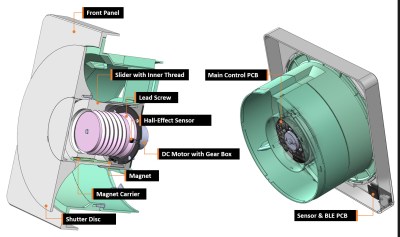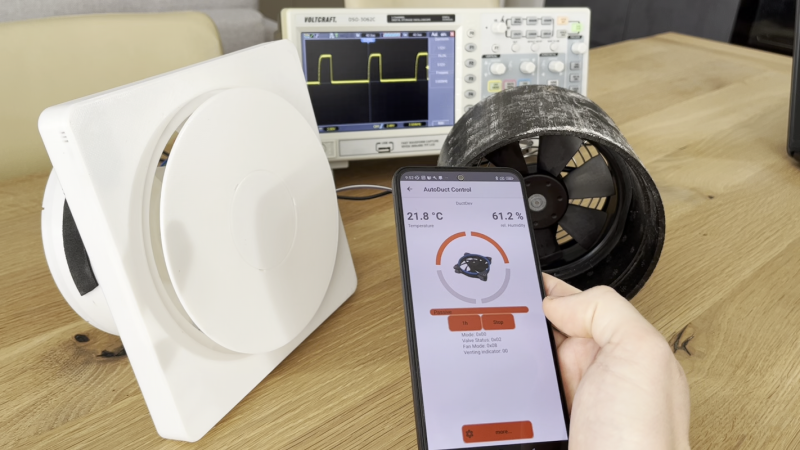Modern building techniques are relying more and more on passive elements to improve heating and cooling efficiencies, from placing windows in ways to either absorb sunlight or shade it out to using high R-value insulation to completely sealing the living space to prevent airflow in or out of the structure. One downside of sealing the space in this fashion, though, is the new problem of venting the space to provide fresh air to the occupants. This 3D printed vent system looks to improve things.
 Known as the AutoDuct, the shutter and fan combination is designed to help vent apartments with decentralized systems. It can automatically control airflow and also reduces external noise passing through the system using a printed shutter mechanism which is also designed to keep out cold air on windy days.
Known as the AutoDuct, the shutter and fan combination is designed to help vent apartments with decentralized systems. It can automatically control airflow and also reduces external noise passing through the system using a printed shutter mechanism which is also designed to keep out cold air on windy days.
A control system enables features like scheduling and automatic humidity control. A mobile app is available for more direct control if needed. The system itself can also integrate into various home automation systems like Apple’s HomeKit.
A 100% passive house that’s also as energy-efficient as possible might be an unobtainable ideal, but the closer we can get, the better. Some other projects we’ve seen lately to help climate control systems include this heat pump control system and this automatic HVAC duct booster fan system.


















If you’re about to get new windows, consider ordering them with an automatic vent like this one:
https://www.regel-air.com/
These air valves don’t cost much, but should be factory fitted for best results.
How do they keep the flies and other bugs out?
Have a look at the pictures in the more detailed german description. A part of the outer window seal is made imperfect on purpose and creates a narrow slit with a width comparable to mosquito net mesh size. The air flows around the window frame in the space between inner and outer seal, which also acts as a dust filter that can easily be cleaned and the air gets somewhat pre-warmed to prevent cold spots and condensation on the inside. The valve closes at a pressure difference >600 Pa so that gusts and strong winds can’t force water and dirt in. This method lets enough air through to keep existing bathroom exhausts working, even passive ones, without sacrificing thermal insulation. Typical use cases are houses and condos with central or district heating and electric cooking.
I recently got new windows with these valves and it took me a while to figure out how they work. IMHO they qualify as a (commercial) hack.
This will never remove condensation issue! Only gravity or mechanical vents. Most of British houses had water on the windows and mold because this tiny holes which you are selling do not work! Easy to observe and not a rocket science
This isn’t supposed to remove condensation. It’s supposed to let mechanical ventilation work which will control humidity and remove condensation. Too many homes these days are sealed in boxes causing ventilation systems to do very little.
It looks like the original creator did not write much about these decentralized ventilation ducts that this is made for, since they are common in his area, but as I hadn’t seen them in a building before I looked into it. In the video it turns out that the duct this is meant for is a bit bigger than a dryer duct, except it’s got a fan AND a ceramic honeycomb thermal mass (which he labels as a heat exchanger but is actually more like a fixed regenerator like what’s in a stirling engine). I say that because it works with cyclically reversed flow instead of two simultaneous fluid streams.
The thermal mass would begin with each end near the ambient temperature of each side and a gradient between. Then, when the fan blows in either direction, the temperature that comes out will gradually rise or fall until it’s the same as what’s on the other side of the mass, and the mass has no more gradient on it. Reversing the direction at this time will output a constant temperature until the gradient forms, then it will eventually reach the other side’s temperature. So to maintain the temperature difference the best is to flow an infinitesimal amount of air before reversing direction, which is to say that normal operation will be a compromise. Also, there’s an assumption that air volume may enter or leave from somewhere else when in operation. The best way seems as if it would be for an equal number of these to be in opposite phase at any given time, so that air is never having to flow through cracks and drafts instead of flowing through a regenerator on a vent somewhere. If they all spend most of the time sealed, this cannot happen without electronic synchronization, but if they don’t, it’d average out somewhat.
A poorly sealed home easily replaces the air that leaves through normal exhaust vents, but it’s an efficiency loss, and with a portable air conditioner it’s well known that if you have a single air exhaust hose without an outdoor intake hose, you will end up sucking hot outdoor air into the house from somewhere to replace what you vent out, making the house warmer than you’d like even if you insulate your hot exhaust. That’s why they’re one of the least effective kinds of air conditioner, and illustrates why it’d be important to know where is acting as the other side of your vent when it runs.
If you’ve got more room than these little ducts allow, there are two ways more familiar to me than these cyclic units which do a similar job – Heat Recovery Ventilators and Energy Recovery Ventilators. The first is commonly a counterflow (or often crossflow, for reasons of price) plate heat exchanger. The second is often similar, except the plates of the exchanger are permeable so that the humidity is generally retained on the side it came from. There’s many ways to do it, and sometimes in larger scales they use thermal wheels which are like the mass in this article except they’re rotated between streams in order to get better results.
“A poorly sealed home easily replaces…” . We call that letting the house breathe :) . Ours was built in ’55 and like it that way. During the summer it really takes deep breathes as we leave windows open. Doesn’t get warm enough to need an air conditioner 98% of the year.
Forgot to say, we don’t own an air conditioner for that very reason, although are neighbors seem to like them :rolleyes: . Not worth getting one for a few days of the year, just to be ‘cool’ :) in my mind.
Slider, threads, and moving parts coated with dirty rain that can come in the top side. Small round ring restriction point compared to duct size. Bugs and bugs with legs.
This is the part inside the building. The one that is not named ‘external grille’ in the drawing.
8 mm millimeter travel size is enough to get the same cross section as a 100 mm duct.
Go home, ecodelta.
This is exactly wat I need!
Where can I buy this stuff?
Who can I pay to build this for me!
Who will take my money!
Ask a local professional for suitable solutions that comply with building and safety codes. Flammable material like 3D-printed stuff is usually not allowed inside air ducts.
At one point I needed a fume extractor for a garage workbench where some of the fumes were liable to be flammable and after some tinkering realized that a 100mm electric ducted fan (like you’d use on a decent sized RC plane) and some anodized aluminum roof flashing and an anodized aluminum frame among with some good solvent-and-corrosion resistant flexible ventilation duct did wonders.
It make working with unpleasant etchants, solvents, etc. much less icky by extracting ~350CFM measured at the outdoor vent at the far end and the brushless motor avoids sparks that might ignite solvent fumes and using an overspec’d fan and motor at only 2/3 of its rated voltage combined with the airflow cooling it means it doesn’t get
hot even when run for 36 hours at a stretch.
There is a lot to be said for putting in the time and effort up front to build a custom ventilation unit because when you have a setup tailored exactly to your requirements it makes a big difference in the comfort and usability of a space to an impressive degree.